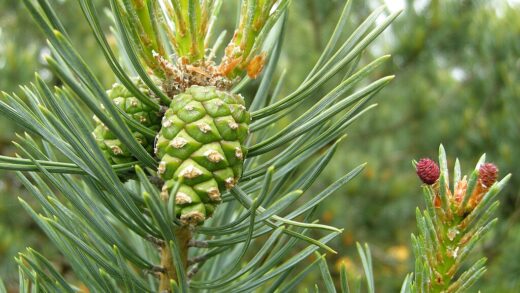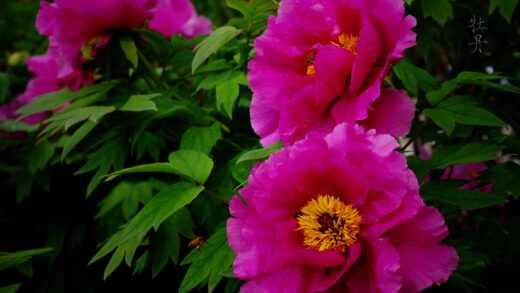When considering the nutrient requirements and fertilization of American pokeweed, the most important thing for a gardener to understand is that this plant generally thrives on neglect. As a native species that is often found colonizing disturbed land, roadsides, and woodland edges, it is exceptionally well-adapted to surviving and even flourishing in average to poor soils. It has a robust and efficient root system that is adept at extracting the necessary nutrients from the ground without the need for supplemental feeding. In most garden settings, providing extra fertilizer is not only unnecessary but can also be counterproductive, leading to overly lush, weak growth and exacerbating its already vigorous, sometimes invasive, tendencies.
The plant’s natural habitat provides the best clues to its nutritional needs. It prospers in soils that are rich in organic matter, such as the humus-laden floor of a deciduous forest. This suggests that it appreciates a soil structure that is loose and friable, with a slow and steady supply of nutrients released from decomposing organic material. However, its presence on depleted construction sites and in abandoned fields also demonstrates its remarkable ability to get by with very little. This adaptability is a key trait, meaning you do not need to spend time and money on creating a perfect, nutrient-rich soil environment for it.
For the vast majority of gardeners, the best approach to feeding American pokeweed is to not feed it at all. If you are planting it in reasonably good garden soil, it will have everything it needs to grow to its impressive mature size. Adding a balanced synthetic fertilizer, especially one that is high in nitrogen, can cause the plant to produce excessively rapid and soft growth. This can make the tall, hollow stems more susceptible to breaking in strong winds or heavy rain. Furthermore, it can stimulate the plant to grow even larger and more aggressively than it naturally would, creating more of a management challenge.
Instead of using concentrated fertilizers, focus on enriching the soil’s organic content, which provides a more balanced and slow-release form of nutrition. Amending the soil with compost at the time of planting is usually sufficient for the entire life of the plant. You can also apply a top dressing of well-rotted manure or a layer of organic mulch, such as shredded leaves or wood chips, around the base of the plant. As these materials break down over time, they will slowly release nutrients into the soil, mimicking the natural processes that the plant is adapted to and providing all the nutrition it will ever need.
Understanding its modest nutrient needs
The key to a successful fertilization strategy for American pokeweed is to recognize how modest its nutrient needs truly are. This plant has evolved to be a survivor and a colonizer, with physiological traits that allow it to be highly efficient in its nutrient uptake. Its deep taproot not only searches for water but also explores a large volume of soil for essential minerals like nitrogen, phosphorus, and potassium. This extensive reach means it can often find the nutrients it needs even in soils that would be considered poor or infertile for more demanding horticultural plants like roses or tomatoes.
More articles on this topic
Pokeweed is not what is known as a “heavy feeder.” It does not require a constant, high level of nutrients to perform well. In fact, it is the opposite. Its growth habit is naturally vigorous, and adding excess nutrients simply supercharges this growth to a level that can become problematic in a managed garden setting. The goal of a gardener is typically to maintain a healthy but well-behaved plant. Over-fertilizing pokeweed works against this goal, encouraging it to become a larger, more dominant presence that can outcompete and overshadow its neighbors.
The plant’s life cycle is also adapted to modest nutrient availability. It puts on a tremendous amount of growth in the spring and summer, and then the entire herbaceous structure dies back to the ground in the winter. As the dead leaves and stems decompose on the soil surface over the winter, they return a portion of the nutrients they used back to the soil, creating a self-sustaining cycle. By leaving the debris in place for a portion of the winter (before a final cleanup in late winter or early spring), you can help to replenish the soil in the immediate vicinity of the plant.
If you observe your pokeweed and it has reasonably green leaves, strong (though not excessive) growth, and produces flowers and berries, you can be confident that it is getting all the nutrients it needs from the existing soil. Signs of nutrient deficiency, such as widespread yellowing of the leaves (chlorosis), are extremely rare in this plant. More often, any perceived problems are related to other factors like water stress or disease. Trust in the plant’s inherent self-sufficiency and resist the urge to fertilize.
The role of organic matter
While synthetic fertilizers are generally discouraged for American pokeweed, the addition of organic matter to the soil is highly beneficial and aligns perfectly with the plant’s natural preferences. Organic matter, in forms like compost, leaf mold, or aged manure, improves the soil in numerous ways that support the healthy, controlled growth of pokeweed. It provides a slow, steady release of a wide spectrum of nutrients, as opposed to the sudden, powerful jolt delivered by chemical fertilizers. This “slow food” approach prevents the kind of weak, leggy growth that over-fertilization can cause.
More articles on this topic
Beyond providing nutrients, organic matter fundamentally improves the physical structure of the soil. In heavy clay soils, it helps to separate the fine clay particles, improving drainage and aeration, which is crucial for preventing the pokeweed’s large taproot from rotting. In sandy soils, which can drain too quickly and do not hold nutrients well, organic matter acts like a sponge, helping the soil to retain both moisture and essential minerals. A soil with good structure allows the plant’s roots to grow deep and strong, reinforcing its natural resilience.
Incorporating organic matter is best done at the time of planting. When you are preparing the hole for your new pokeweed plant, mix a generous amount of compost or other well-decomposed organic material into the backfill soil. This will give the plant a fantastic start and will continue to provide benefits for years to come. For established plants, you can apply organic matter as a top dressing. Simply spread a layer of compost, two to three centimeters thick, on the soil surface around the base of the plant in the spring. Natural processes like rain and soil life will gradually work it down into the root zone.
Using organic mulches is another excellent way to incorporate organic matter. Applying a layer of shredded leaves, wood chips, or straw around the plant will not only suppress weeds and conserve moisture but will also slowly decompose over the course of the season. This decomposition process adds valuable organic material directly to the top layer of the soil, feeding the soil ecosystem of beneficial microbes and fungi, which in turn helps to make nutrients more available to the plant’s roots. This holistic approach of feeding the soil, not the plant, is the ideal strategy for pokeweed.
Why to avoid synthetic fertilizers
There are several compelling reasons to strictly avoid the use of synthetic fertilizers on American pokeweed. The primary reason is the risk of promoting excessive and structurally weak growth. High-nitrogen synthetic fertilizers, in particular, will cause the plant to grow incredibly fast and lush. However, this rapid growth often results in elongated, soft plant cells, leading to stems that are brittle and floppy. A pokeweed that has been over-fertilized is much more likely to be damaged or completely flattened by summer thunderstorms or strong winds, ruining its ornamental effect.
Synthetic fertilizers can also negatively impact the overall health of the soil ecosystem. These fertilizers provide a concentrated dose of soluble nutrients directly to the plant but do nothing to feed the beneficial microorganisms, fungi, and earthworms that create a healthy, living soil. Over time, a reliance on chemical fertilizers can lead to a decline in soil health, structure, and natural fertility. Since pokeweed is a long-lived perennial that thrives in a healthy, natural soil environment, it is much better to support this ecosystem with organic matter rather than bypass it with chemicals.
Furthermore, the runoff of synthetic fertilizers can have negative environmental consequences. Excess nutrients, particularly nitrogen and phosphorus, that are not taken up by the plant can be washed away by rain or irrigation into local waterways. This nutrient pollution can contribute to algal blooms in ponds and streams, which deplete the oxygen in the water and can be harmful to fish and other aquatic life. Given that pokeweed does not even require these fertilizers, using them represents an unnecessary environmental risk.
Finally, using synthetic fertilizers on pokeweed is simply a waste of time, effort, and money. This is a plant that is genetically programmed to thrive with minimal inputs. One of its greatest virtues as a garden plant is its self-sufficiency. To spend resources on fertilizing it is to misunderstand the fundamental nature of the plant and to work against its natural tendencies. By embracing a no-fertilizer approach, you are not neglecting the plant; you are actually providing it with the exact conditions it is adapted to, allowing it to be the strong, resilient, and beautiful plant it is meant to be.
Amending soil at planting time
The single most effective time to address the nutritional needs of an American pokeweed plant is at the moment you plant it. By amending the soil in the planting hole, you can create an ideal environment that will support the plant for many years, if not its entire lifespan, without the need for any further fertilization. This initial investment in soil preparation pays long-term dividends in the form of a healthy, robust, and self-sufficient plant. The goal is not to make the soil overly rich, but to improve its structure and provide a long-term source of slow-release nutrients.
Before you dig the planting hole, assess the native soil. Is it heavy clay that stays wet? Or is it sandy and drains instantly? If you have heavy clay, the primary amendment should be compost, which will help to break up the dense particles and improve drainage. If you have very sandy soil, compost is also the ideal amendment, as it will help the soil to retain moisture and nutrients. For an average loam soil, a simple boost of compost will still be beneficial. The universality of compost makes it the perfect amendment for pokeweed in almost any situation.
When you dig the hole for your new plant, make it about twice as wide as the root ball but no deeper. Set the soil you excavate aside on a tarp or in a wheelbarrow. Then, mix this native soil with a generous amount of compost. A good ratio is approximately two parts native soil to one part compost. Mix it together thoroughly, breaking up any large clumps. This creates a homogenous backfill mix that will provide a perfect transition for the plant’s roots as they grow out from the root ball into the surrounding garden soil.
Use this amended soil mixture to backfill the hole around the plant’s root ball, firming it gently as you go. After you have finished planting and have watered the plant in thoroughly, you can add one final touch. Apply a five to seven centimeter layer of organic mulch, like wood chips or shredded bark, on top of the soil around the plant. This mulch will further enhance the soil over time as it breaks down, in addition to its immediate benefits of conserving moisture and preventing weeds. This comprehensive preparation at planting time is the only “fertilization” your pokeweed will likely ever need.


















